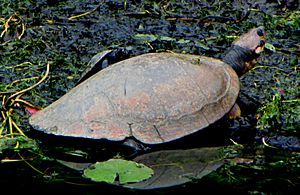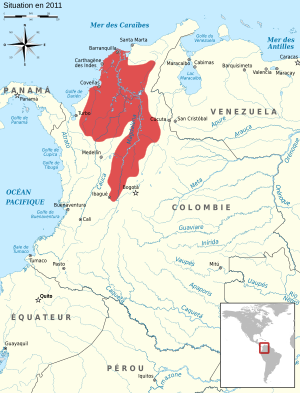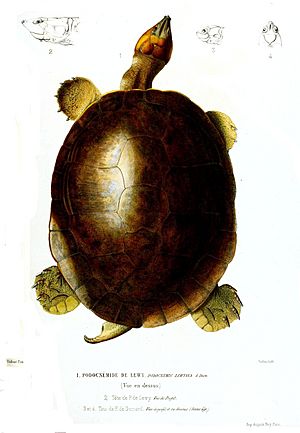Magdalena River turtle facts for kids
Quick facts for kids Magdalena River turtle |
|
|---|---|
 |
|
| From Medellin, Colombia | |
| Conservation status | |
| Scientific classification | |
| Genus: |
Podocnemis
|
| Species: |
lewyana
|
 |
|
| Range in red | |
| Synonyms | |
|
Podocnemis coutinhii Göldi, 1886 |
|
The Magdalena River turtle (Podocnemis lewyana) is a special type of turtle. It belongs to a family of turtles called Podocnemididae. These turtles have been around for a very long time, since the Cretaceous Period, about 100 million years ago!
This turtle only lives in northern Colombia. You can find it in the Sinú, San Jorge, Cauca, and Magdalena river areas.
Sadly, the Magdalena River turtle is in big trouble. In 2015, the IUCN (a group that tracks endangered animals) said it was "Critically Endangered." This means it's very close to disappearing forever. Its numbers have dropped by more than 80% in less than 25 years. This is mostly because its home is being destroyed or polluted. People also catch too many of them. Changes to rivers from power plants and climate change also hurt these turtles. Scientists are now working hard to find the best ways to protect them.
Contents
About the Magdalena River Turtle
Magdalena River turtles look a bit different depending on if they are male or female. This is called sexual dimorphism. Both male and female turtles have a strong shell made of shield-like plates. Their shells are mostly brown. They also have thick necks and strong heads.
You can tell males and females apart by their head scales. Males have grayish-brown head scales. Females have more reddish-brown head scales. Adult males usually weigh about 1.6 kilograms (3.5 pounds). Their shell is about 24.6 centimeters (9.7 inches) long. Females are much bigger! They usually weigh about 5.6 kilograms (12.3 pounds). Their shell can be about 37 centimeters (14.5 inches) long.
These turtles mostly eat plants. This means they are herbivores. But sometimes, they might eat insects if they get the chance. Young turtles might even eat small fish. In the wild, these turtles usually live for 10 to 15 years.
Life Cycle and Habits
Reproduction and Nesting
Magdalena River turtles lay eggs many times in their lives. This is called being iteroparous. Males are ready to have babies when they are 3 to 4 years old. Females are ready when they are 5 to 6 years old. Female turtles build their nests in the sandy banks of the rivers. These are usually in shallow water areas.
There are two main times of year when they lay eggs. One is from December to January. The other is from June to July. Scientists are not sure if one female turtle lays eggs in both seasons in the same year. More eggs are usually laid during the June-July season.
However, the eggs laid in the December-January season are usually heavier. Heavier eggs often mean healthier baby turtles. Because of this, scientists say it's important to protect both nesting seasons.
On average, a female turtle lays about 22 eggs in one clutch. The temperature of the nest affects whether the baby turtles will be male or female. This is called temperature-dependent sex determination. If the nest temperature is around 33.4°C (92.1°F), there will be an equal number of male and female babies. If the temperature is cooler, more males will hatch. If it's warmer, more females will hatch. People are worried that climate change might affect this natural process.
How Turtles Move
Magdalena River turtles are known for traveling long distances in the water. They are freshwater turtles. They rarely leave the water, except to warm up in the sun. Their usual home area is between 10.3 and 14.6 hectares (about 25 to 36 acres).
How much they move depends on many things. This includes if they are male or female, how big they are, and how much food is available. The quality of their habitat, the season, and if they are ready to reproduce also affect their movement.
They move the most when water levels change with the seasons. Research shows they move to deeper waters when it gets warmer. This is likely because of climate change.
Protecting the Magdalena River Turtle
Why These Turtles Are in Danger
In 2018, about 37% of all freshwater and land turtles in Colombia were "Threatened." Even though a law was passed in 1964 to protect them, their numbers keep going down. Many things caused by people have hurt the Magdalena River turtles. The biggest problems are people catching too many of them and climate change.
People catch these turtles to eat them. Some local people believe that eating the turtles has special medicinal powers. They think it can help with pregnancy recovery, cure diseases, or make them stronger and live longer.
Climate change is also a big problem. It changes the temperature, which affects whether baby turtles are male or female. It also changes where the turtles move. Warmer temperatures can cause nesting sites to flood. This changes their homes.
Besides human actions, some natural things also make these turtles vulnerable. Many eggs, hatchlings, and young turtles die. Even though older turtles survive well, they grow slowly. This means it takes a long time for them to reach adulthood. They also need different types of habitats. They need one place to nest and another to find food. This means they have to make difficult journeys.
What People Are Doing to Help
One common way to help Magdalena River turtles is called "head-starting." This means raising young turtles in a safe place until they are bigger. Then they are released into the wild. Scientists are also looking for even better ways to help. We are still learning a lot about how endangered these turtles are.
One study looked at 16 different things about Colombian freshwater and land turtles. It suggested that the Magdalena River turtle should be the top priority for protection. Scientists are using faster ways to study the turtles' life stages. This helps them understand how to best protect them.
Surveys show that local people are eating fewer turtles now. They also know more about how important these turtles are to the environment. This means that working with local communities is helping. Sharing educational materials is making a difference in saving the Magdalena River turtles.
See also
 In Spanish: Tortuga del río Magdalena para niños
In Spanish: Tortuga del río Magdalena para niños



